 Weird Stuff
Weird Stuff  Weird Stuff
Weird Stuff  Mysteries
Mysteries 10 Tragic Disappearances and Deaths in Joshua Tree National Park
 History
History 10 Ways Childhood Really Sucked in the Old West
 Music
Music 10 Name Origins of Famous Bands from the 1990s
 Religion
Religion 10 Biggest Turnarounds by the Catholic Church
 Weird Stuff
Weird Stuff 10 Unbelievable Times Laws Had Unintended Consequences
 Humans
Humans Ten Historic Women Who Deserve Way More Credit Than They Got
 Movies and TV
Movies and TV 10 Films That Spawned Major Lawsuits
 History
History Ten Times Towns Were Wiped Off the Face of the Earth
 Creepy
Creepy 10 of the Most Disturbingly Haunted Public Houses in the UK
 Weird Stuff
Weird Stuff 10 Niche Subcultures That Are More Popular Than You Might Think
 Mysteries
Mysteries 10 Tragic Disappearances and Deaths in Joshua Tree National Park
 History
History 10 Ways Childhood Really Sucked in the Old West
Who's Behind Listverse?

Jamie Frater
Head Editor
Jamie founded Listverse due to an insatiable desire to share fascinating, obscure, and bizarre facts. He has been a guest speaker on numerous national radio and television stations and is a five time published author.
More About Us Music
Music 10 Name Origins of Famous Bands from the 1990s
 Religion
Religion 10 Biggest Turnarounds by the Catholic Church
 Weird Stuff
Weird Stuff 10 Unbelievable Times Laws Had Unintended Consequences
 Humans
Humans Ten Historic Women Who Deserve Way More Credit Than They Got
 Movies and TV
Movies and TV 10 Films That Spawned Major Lawsuits
 History
History Ten Times Towns Were Wiped Off the Face of the Earth
 Creepy
Creepy 10 of the Most Disturbingly Haunted Public Houses in the UK
Top 10 Sushi Bites
To my surprise, this website has yet to post (until now) a top ten list about sushi. It has been mentioned numerous times, notably on the lists “Top 10 Luxury Foods” and “Top 10 Bizarre Restaurants,” but has never had a list on its own. So I’ve taken the initiative.
These are the top 10 most delicious bites of sushi. I’ve chosen items that are reasonably available on the market, and that, like Jamie Frater’s “Top 10 Korean Food You Have to Try,” represent a variety that any self-respecting sushi eater should set the goal to try in their lifetime. Naturally, this list is very personal opinion based, but to give some brief credentials on me, I am a sushi chef and have made sushi on a professional level since 2005, and have been eating sushi since long before that, both Stateside and in Japan. My selections are intended for a board spectrum of sushi eaters, ranging from the beginner (even the “sushi virgin” as we like to say), to even the most well-versed “sushi snobs” among us.
By “Sushi Bites” I’ve included items that are both, as a matter of semantics, sushi and sashimi. This covers most all sushi-related techniques and ingredients involving raw fish and cooked fish, with or without sushi rice. I also tried to give both the English and Japanese names for things.
I’ve also done my best to describe the individual tastes of the items, but that is difficult writing territory with certain limitations. (How would you describe the taste of salt, for example, other than saying “salty”?) Besides all that, I hope to provide good information and a lot of new trivia knowledge to each reader, as any list ought to do.
Enjoy.
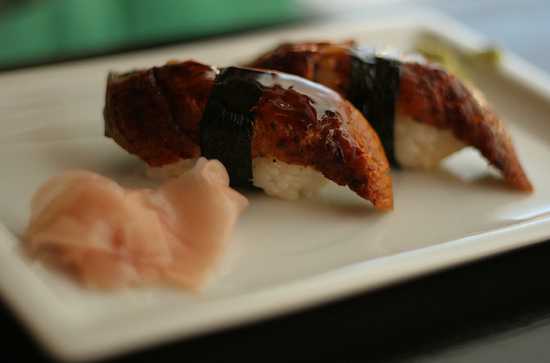
We’ll start with an easy one in eel. Unagi (the freshwater variety of eel, as opposed to its marine brother Anago) has long been a mainstay in Japan, and has recently surged in popularity in the United States too. It is described as rubbery but not chewy, earthy and mushroomy, if that makes sense. Probably the most chicken-like sushi meat, it isn’t too big of a leap for first-timers once they get over the fact that it’s an eel.
Almost all sushi restaurants get it farm-raised, pre-packaged and grilled in a teriyaki-like sauce, making a taste that incorporates elements of sugar, soy sauce, sesame seeds and sugar, and for the most part that is widely consistent from restaurant to restaurant. It’s also not uncommon for it to be served warm, which is unique for sushi.
In the US, a common item featuring Unagi is the inside-out style of sushi roll (Uramaki style) known as the Caterpillar. There is no exact definition of a Caterpillar Roll, as each restaurant usually has their own version, but it usually pairs Unagi with avocado (the important thing) and various other ingredients. [Image Source]
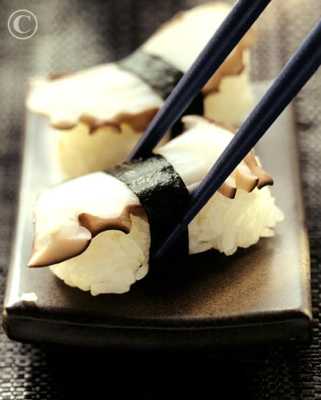
Also rubbery, the meat cut from an Octopus tentacle can be quite dense and chewy. It has a subtle, cleanly delicious taste that gives it a particular, yet loyal, fan base.
Most all Nigiri-style sushi (that is, slices of fish on top of a hand-formed ball of rice) will contain a small amount of hot wasabi. (This is applied at the chef’s discretion, and Unagi is the typical exception to this practice). The taste of Tako, however, is exceptionally enhanced by the wasabi and so it might be given much more than the other pieces, on average. What is also special about Tako is that instead of being cut by a single, one-directional motion, as is the rule for cutting other fish, it is cut in many short and quick sawing motions, resulting in a corrugated surface. This was originally done as a way of demonstrating to customers that the specimen was parasite-free, but it stuck as a tradition.
Outside of Japan, the whole octopus is thoroughly boiled before it is carved, resulting in a very opaque white flesh and a dark purple skin. In Japan it is served similarly, although it can sometimes also be served raw and grey, and a lot chewier.
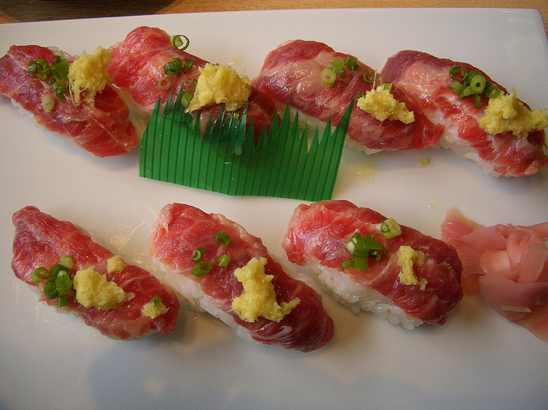
Attitudes towards the human consumption of horse meat depend on the region. It is vastly most popular in East Asian countries, Japan, China and Korea, where it is a frequent delicacy. Elsewhere in the world it is less common, but present; places like South America, the Middle East and Continental Europe. It is far more scarcely available in the UK, Australia and Canada, and least of all in the United States, where it strongly opposed and viewed by many as taboo.
In Japanese, Horse meat is generally referred to as Sakura-niku (which means “cherry blossom steak”), but when it is cut into thin slices and served sashimi style, it is called Basashi. It is very lean and fairly tender, tasting close to other rare-prepared red meat like beef and mutton (more so beef, but definitely distinct from beef). It actually contains much less fat than beef, and twice the iron. Without a doubt, the best garnish for Basashi is freshly grated ginger and diced onions. This is a must. [Image Source]
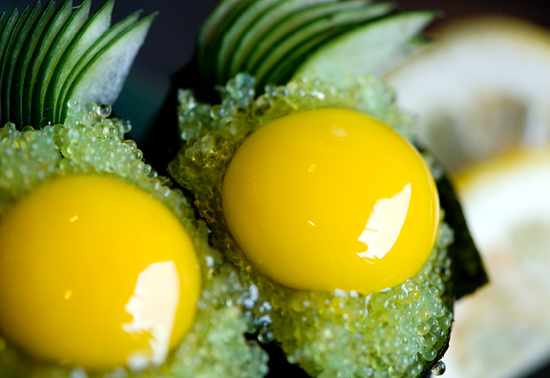
Tobiko is the roe (ovaries) harvested from flying fish. It is used as a component in many Japanese dishes, and in the US it is most commonly seen on the outside of California Roll or “Golden” California Rolls. However, it earns a spot on our list for when it is served as the primary ingredient, in a style known as Gunkan-maki or “Battleship Style.”
Plain Tobiko is orange, salty in taste, and crunchy in texture. Occasionally it is served with a raw quail egg cracked directly on top of the battleship piece, with a Shiso leaf (think of a mint leaf, but not exactly). This is a very fancy item with, needless to say, a complex flavor.
Tobiko comes in an assortment of alternative flavors and colors; wasabi (green), squid ink (black), spicy hot (red), and yuzu, a citrus fruit (yellow). Often Tobiko is substituted with the cheaper Masago (roe of capelin), but Masago eggs are slightly smaller in size, messier, and a lot brighter orange. It’s easy to tell the difference when they are side by side, so it just takes experience to know what you are looking at.
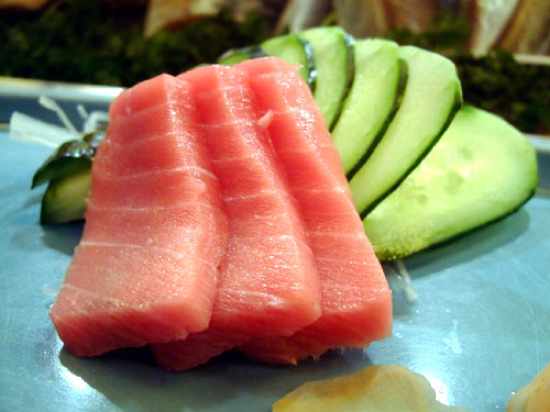
Perhaps the single most extensively used wild-caught fish in sushi, on a global scale, is the Bluefin Tuna. It is so overfished, in fact, that it is very threatened as a species, which in turn is considered a major sustainability risk to the world oceans as a system. A Greenpeace activist once told me that there are more frozen Bluefin tunas than live ones. For this reason, a lot of people, including myself, have started to avoid Bluefin more and more. Now having said that, as long as you’re not eating it everyday, I would be the last person to cast aspersions.
The Bluefin (Maguro) yields different cuts for sushi. The greater part of the fish, and therefore the most common and the cheapest, is called Akami. This is a dark red cut that comes from the spine and tail. Moving closer to the head, the Chu-Toro is a fattier flesh with a richer flavor, and from there, moving toward the anterior belly, is the Toro, the most marbled and the most highly valued. The absolute fattiest cut of Toro is referred to as the O-Toro or Oho-Toro. This piece melts in your mouth like butter.
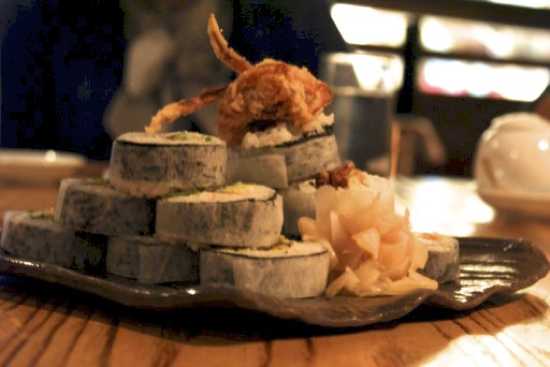
Together with tuna, salmon invariably constitutes any chef’s top-selling fish, both in volume and for profit. Because of this fact, chefs inescapably find themselves with a seemingly endless surplus of salmon skin, which is cut off and not included in the nigiri, sashimi and other rolls. With all the extra skin around (granted, the chef must make a conscious effort to scale the fish and save the skin, instead of discarding it indiscriminately), there is always the possibility that a chef will be happy to make a Salmon Skin Roll, even if it’s not on the menu.
The skin, a speckled gradient of white, silver and black, tastes like a combination of the fish itself and the pungent seawater in which it lived. It should be baked or broiled beforehand, which makes its overall prevailing quality one of “toasty.” Hard to describe beyond that. Sometimes the skin is smoked, which is a flavor all by itself, but that also can be a real treat. Either way, it is rolled up into something routinely called a B.C. Roll (British Columbia) or Philadelphia Roll (indicating cream cheese) with other things such as cucumbers or crab, or whatever. But believe me, the salmon skin is what you will taste.

Amaebi is the translucent, delicate tails of shrimp that are served raw as either nigiri or sashimi. It should not be confused with Ebi, the type of sushi shrimp that are more familiar to the layman: bigger, plainer tasting, always cooked, frequently over-cooked, and which would be disgusting and probably unsafe were it served raw. Amaebi is commonly serves with either Tobiko or Ikura (salmon eggs) on top.
The Amaebi shrimp, in addition to being very scrumptious, are furthermore intriguing in that, insomuch as the traditional sushi experience is concerned, they present the closest thing to eating a live organism (fringe practices notwithstanding). What will happen is that in one brief sequence the chef will separate the tail from the abdomen, manually remove the shell and the barb from the tail, cleans the venous cavity, and commences with the presentation of the dish, which often includes the immediately detached head. I hesitate to say that it’s a live food, though, because at this point survival for the animal is of course an impossibility, although if the customer is lucky some minor twitching will occur. Let’s just say this: It certainly won’t be the least-alive thing you will ever try in your life.
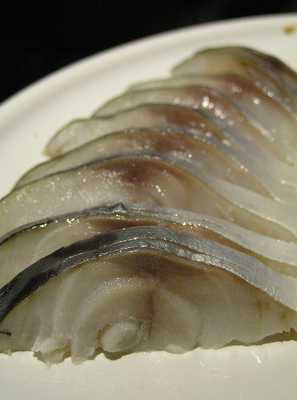
Shime Saba is the sushi name for a Mackerel (Saba) that has been pickled. It is very potently flavored, too intensely for some, very vinegary and salty (naturally, from the curing process), very fishy (in a good way), and very, very oily. Eating more than one piece at a sitting would definitely be over-doing it. Unless you just really love it, I suppose.
It also has a notorious aftertaste which I won’t even attempt to describe. Shime Saba is definitely one of those things that people either love or hate. Most, I have found, eventually admit they love it.
The flesh is a very mundane light-tan color, but the skin is very shiny, silvery, with salamander-like blotchy stripes that can be very blue in tone (not unlike a Na’vi’s skin from the movie Avatar). To my knowledge, a slice of Shime Saba sushi is the only naturally occurring instance of blue meat. For that reason alone you simply must try it if you haven’t. [Image Source]
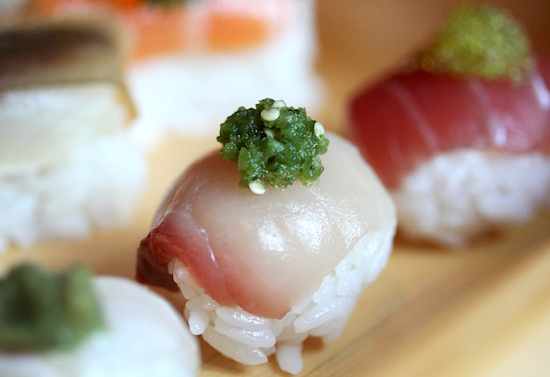
In sushi parlance, “Yellowtail” (Hamachi) refers to a species of fish whose common English name is Japanese Amberjack. This is not to be confused with Yellowtail Amberjack, whose sushi name is Hiramasa, and that is also sometimes called Mossback or White Salmon. Nor is it to be confused, which it often is, with any species of tuna or mackerel, such as the Skipjack, whose sushi name is Katsuo, or the Yellowfin, which falls under the umbrella term “Maguro,” or Japanese Jack Mackerel, the whose sushi name is Aji, not to be confused with the Ahi, the Hawaiian name for Yellowfin. Hamachi should be common enough to avoid all this disorder, but it’s always good to know what you’re eating, exactly.
Hamachi has a full, savory flavor due to its high fat content. In fact, during the winter months, the flesh can be so saturated with fat that it will not even hold soy sauce and might actually repel it. Its color can be inconsistent, but it shouldn’t be too white (when it is thereby known as Inada), or red (thereby known as Buri), but should be a heavy pink color, not translucent at all, with a sort of brown tint to it. It will turn more tan as it becomes less fresh, so it should differently be nice and pink. A fresh cut of hamachi is much more flavorful, and at least as buttery, as any cut of Maguro.
God knows why, but Hamachi is just awesome with Jalapeños. This is a relatively new trend, but it is spreading like wildfire, especially with two of America’s top celebrity Japanese chefs, Nobu Nobuyuki and Masaharu Morimoto (the Iron Chef), each offering their own signature take on the combination.
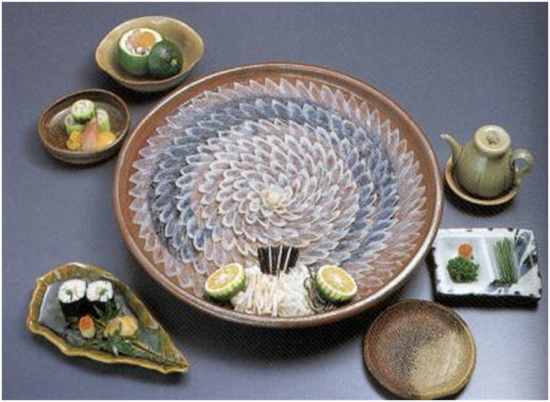
Fugu (pufferfish, or blowfish) must surely be one of the most, if not the most, dangerous glamour food that exists, and the most glamorous danger food that exists. Prepared sashimi-style, it is called Fugu Sashi. It is notorious because of the lethal poison contained in the fish’s liver, intestines and skin. When contaminated by the poison, which can be as much 140,000 times as powerful as cocaine, humans will gradually become fully paralyzed until they die from asphyxiation from not being able to breath. This is all while they remain completely conscious. There is no known antidote.
Fugu laws in Japan are very strict, and chefs require special licensing that goes well beyond that of an average sushi chef. There are Fugu restaurants in New York City, but it is very expensive and the chefs must complete the same demanding Japanese licensure.
To be forthright, the chances of a person dying from eating Fugu are rather low (about the same as dying skydiving). The danger is real and present, however, and this feeling of risk (particularly when you are the first person at the table to try a piece) is very exciting and one of the reasons Fugu is so celebrated. The other reason, and I must emphasize this, is because of how amazingly delicious it is.
Described as “sublime” and “addictive,” the flavor is very subtle and clean, like octopus, but not tough in any way, nor rubbery, nor chewy. Like Hamachi or Toro, it has a mild fishy taste, extremely mild, but it’s there. It has a very smooth, very uniform texture (unlike hamachi or toro, which have grain lines running through them and can be flaky). Even when prepared perfectly, trace amounts of poison come through, and it cause the eater’s mouth to go a little numb; not so much that they can’t feel it, but enough that if they had a cut on their tongue, it wouldn’t hurt anymore.
Fugu is fragile and very transparent. Traditionally it is served on a plate that has a picture of a chrysanthemum flower on it (the Emperor’s symbol) and the detail of the flower should be visible through the super-thin sashimi cuts. The Fugu itself is also typically arranged in the pattern of the flower. The flavor is so soft that you can sit and eat a ton of it in one sitting, which is a good thing.
I’ve only tried it once in my life, but it was the best meal I’ve ever had.

If you are not a fan of sushi or don’t like raw fish products, try Korean kimbap (김밥). Kimbap looks like sushi but it is made with cooked vegetables and meat or fish. The rice is more heavily seasoned so it doesn’t require soy sauce. Kimbap is also wrapped in a different type of seaweed which has a subtly different flavor to sushi. While sushi is popular in Korea, kimbap is the real favorite. You should definitely give kimbap a try if you haven’t had it before – it really is quite delicious. Here is a recipe for making it at home – it is quite easy (as can be attested to by the photo above which was made by Listverse’s founder Jamie Frater. If he can do it, anyone can! [Image Source]








